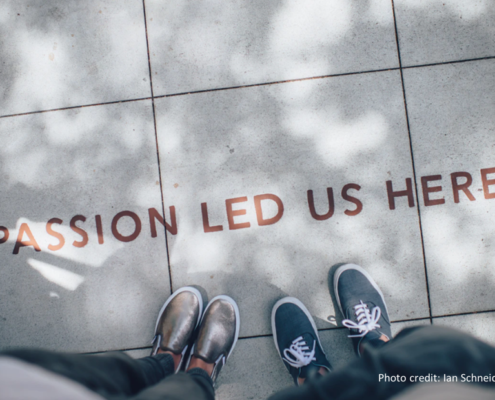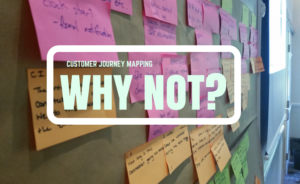The “real” role of a Customer Experience person
Twelve years ago, I left my inhouse, corporate CX roles and set up Empathyce. I’ve had the privilege since then to work with brilliant people in a host of B2B and B2C sectors around the world on their Customer Experience culture and programmes. I’ve seen inside many companies, am always learning and even wrote a book on journey mapping!
But one thing I have seen is how often a role with “Customer Experience” in the job title means different things to different people. If you or your organisation is looking at developing a CX function and the team wants to know what they’re in for, I’ve listed below some of the responsibilities that don’t normally fit a templated job description – feel free to add your own to the list!
So, here goes. Among other things, your role as the go-to CX professional in your organisation is to be…
1 An always-on value expresser – be clear to your boss, colleagues and Board what value you and a focus on CX brings. Keep reminding them what difference it will make and why should they bother listening. In the midst of everything else happening it’s easy for CX to be seen as ‘nice to do’. Plenty of sceptical stakeholders don’t, or don’t want to, get it. They roll their eyes at the very mention of “Customer Experience” and, at best, begrudgingly pay it lip service – but then in the next breath they’ll tell you they’re never going back to a particular restaurant because the service was rubbish. Keep banging the drum!
2 A common thread creator – articulate in just a few memorable words what a customer-led future looks like for everyone. Work to have it adopted as an integral part of the way people work. A future that everyone, whether on the front-line, in a shared back-office function or outsourced third-party can get behind and is rewarded for. Use the aspiration to link what they do with everyone else, not just you.
3 A dot joiner-upper – your organisation-wide view will find people who should be introduced to each other. They might be working on the same customer journey without realising it or they are tackling similar issues. Look for cause and effect – how do the culture, systems and processes create (unintended?) outcomes and financial results. Make sure the CX effort and priorities are aligned with what the Board wants in the short, medium and long term. And, is the experience true to what the brand is spending money on promising?
4 A language changer – shift the perspective and change the internal narrative from “us”, “we” and “our processes” to “customers” and “how does this affect them and their lives?”. Are there examples of internal language you use with customers ‘just because’ it’s always been done that way yet it makes no sense to them? Introduce the concept of emotions in discussion and how the responses to your experiences drive or erode value.
5 A vocal ambassador – shout loud to remind the business that its customers are real people, not tickets or reference numbers or “Dear valued customer”. Do the leaders and managers know who its customer personas really are? Make the voice of the customer heard and understood why it’s important. Keep asking what the impact on a customer is of this process or that decision.
6 A workplace psychologist who watches out for silent assassins and political animals – those who say little in meetings, appearing to nod approval but then put up barriers. They nod their approval to your CX aims but behind your back tell their team to stick to doing whatever makes the most money in the short term. Know when you’re being set up or support is being deliberately withheld. Where you can though, treat your stakeholders with a CX mindset – create value for them and, while it has an obvious serious side, make CX fun for them too.
7 A CX economist – you don’t want to have a reputation for wanting to love your customers without the hard commercial justification. Know how the business makes its money, know where it’s hurting with unnecessary costs, know how many customers you have, gain or lose. Know the difference in behaviours and value between customers who are engaged and like what you do and those who feel ignored or frustrated. Buddy up to the Finance and strategy teams and learn to talk their language.
8 A curious investigative journalist obsessed with understanding “Why..?”. Play detective to find out why certain things happen, both good and bad. Is it down to an individual’s own personality or is the performance management framework unintentionally creating attitudes and ways of working that tick boxes but tick off customers.
9 A party gate-crasher and door knocker downer – get invited to others’ team meetings to understand their world better. Offer value upfront such as running journey mapping workshops for them. As they say, stay close to your enemies. Find out the sub-culture of each function, how they are rewarded and motivated. If a key part of the business is impenetrable from the inside you have to wonder what its impact on customers is.
10 A simplifier – a three or five year plan to thrive and differentiate on Customer Experience can appear overwhelming. It’s about an organisational mindset and that doesn’t change overnight. Break it down into steps, practical actions and be proud to share the successes along the way, however small.
11 A champion of perseverance and resilience – to keep going when everyone around you defends poor experiences because “It’s just what we do” or “Everyone else in the market does it”. They may well have very pressing challenges of their own to deal with but don’t give up. At the heart of CX is a culture, a mindset and that takes time to change. Be patient. If you make progress in leaps and bounds that’s great but all you need is small steps in the right direction and you’ll get there.
12 An Agent Provocateur – poke a stick at the culture by asking the right but searching questions, dare to challenge things that have always been done a particular way, keep nudging in the right direction. How many companies create a poster with some variation of “We put customers at the heart of everything we do” and believe it’s job done? Hold them to account.
13 A cheerleader (or Complacency stamper-outer) – get people fired up about it so they share your passion for what CX can do for the company. Showcase your wins and progress, get them all involved by asking everyone for their ideas and input and keep communicating. Yours won’t be the only strategic project the organisation is working on but keep your CX programme alive and engaging, not just another piece of content in the depths of the shared-drive. Be conscious though that the boundless positivity and optimism may need to be dialled back a peg if you’re dealing with people and teams who are having a tough time.
14 A manager of indirect reports – find your advocates wherever they are and use them to help prioritise activities, to spread the word and open doors. You might start with just a couple of you but the squad can grow into something more structured, effectively giving you access all areas.
15 A battle-chooser – you can’t do everything, just make what you do count. Have a long-list, a strategy but also choose your moments carefully. It’s not a race. Some small sacrifices mean those who were uncooperative to start with begin to see the value and will come round.
16 A healthy cynic – don’t believe everything you see. Is the data really that good or that bad? How is it created, does anyone have a motivation for a little creativity to flatter the numbers? Can you cross-validate it with other data from other sources. Don’t leave any of your assumptions open to challenge.
17 A bar-raiser – keep pushing to improve, whether that’s incrementally or starting afresh. Remind those you work with that customer expectations, set by other companies they deal with, are rising relentlessly. Doing little or nothing is, effectively drifting backwards as the market and customers move steadily (or rapidly) forwards.
18 A fierce protector – don’t let CX become just a project as it’s more about a mindset and a cultural shift. A CX programme can be necessary to put the building blocks in place but eventually the programme should let go and CX is just the way the business does business. Don’t let people think CX now does everything to do with customers otherwise you’ll pick up complaints, compliance and the contact centre to manage. And don’t let your CX surveys get hijacked by others who just want data for data’s sake when they hear you’re talking to customers.
19 A compelling storyteller – bring to life what it’s like to be on the receiving end of what the business does. It describes how it makes customers feel and – as a consequence – what they do next time and say to others. Get creative in the way you collect and share the stories. A score or a metric is useful but add in the context and the impact and people will sit up and take notice. A metric that moves by one decimal place each month won’t set the world alight. A story about why a customer had tears of joy or frustration begins to get traction.
20 An empathiser – it’s worth repeating; make time to understand your colleagues’ world and help them understand how they can champion yours. They have to feel you’re on their side and that you’re prepared to acknowledge their challenges if they are going to help you. Become a strategic ally to them, not just someone who’s always asking for help.
That’s enough to be going on with (the makings of my next book?). There will be more and of course, there’s the core competencies around employee engagement, ROI, strategy, innovation etc. Please feel free to add your own though!
Driving the CX agenda and helping everyone see the benefits is not a short-term or a straightforward role. It has many angles to cover and reaches right across the organisation and beyond. It can be tough but it’s also hugely exciting and rewarding.
Thanks for reading this far! If I can help build and develop your own CX programme, strategy or professional development plans do get in touch – always happy to chat about it!
Jerry Angrave is a Certified Customer Experience Professional and a former inhouse practitioner. In 2012 he founded Empathyce and now helps leadership teams and managers around the world to build effective CX programmes. More details are here.
The Journey Mapping Playbook is available from Amazon at this link
+44 (0) 7917 718 072



















